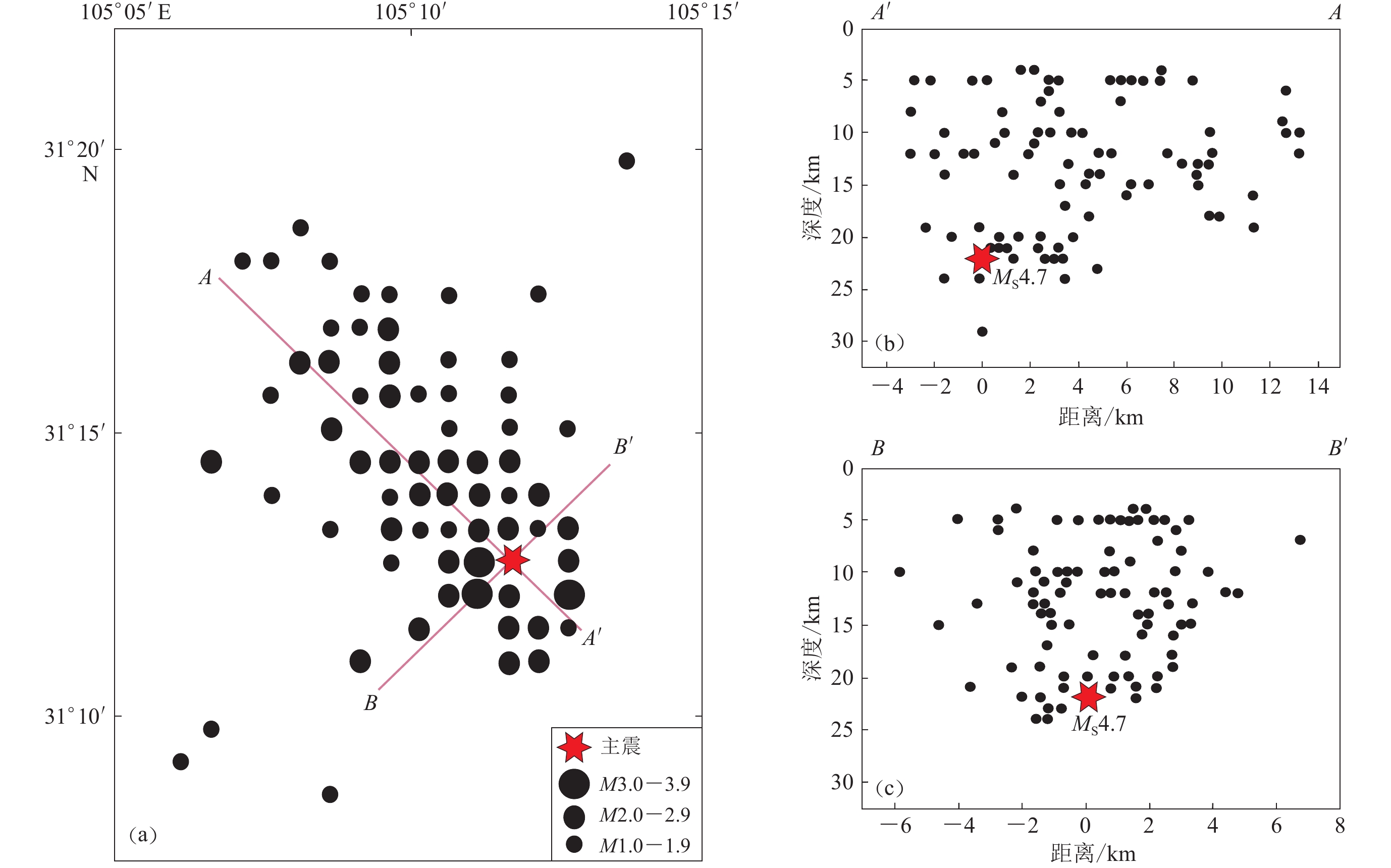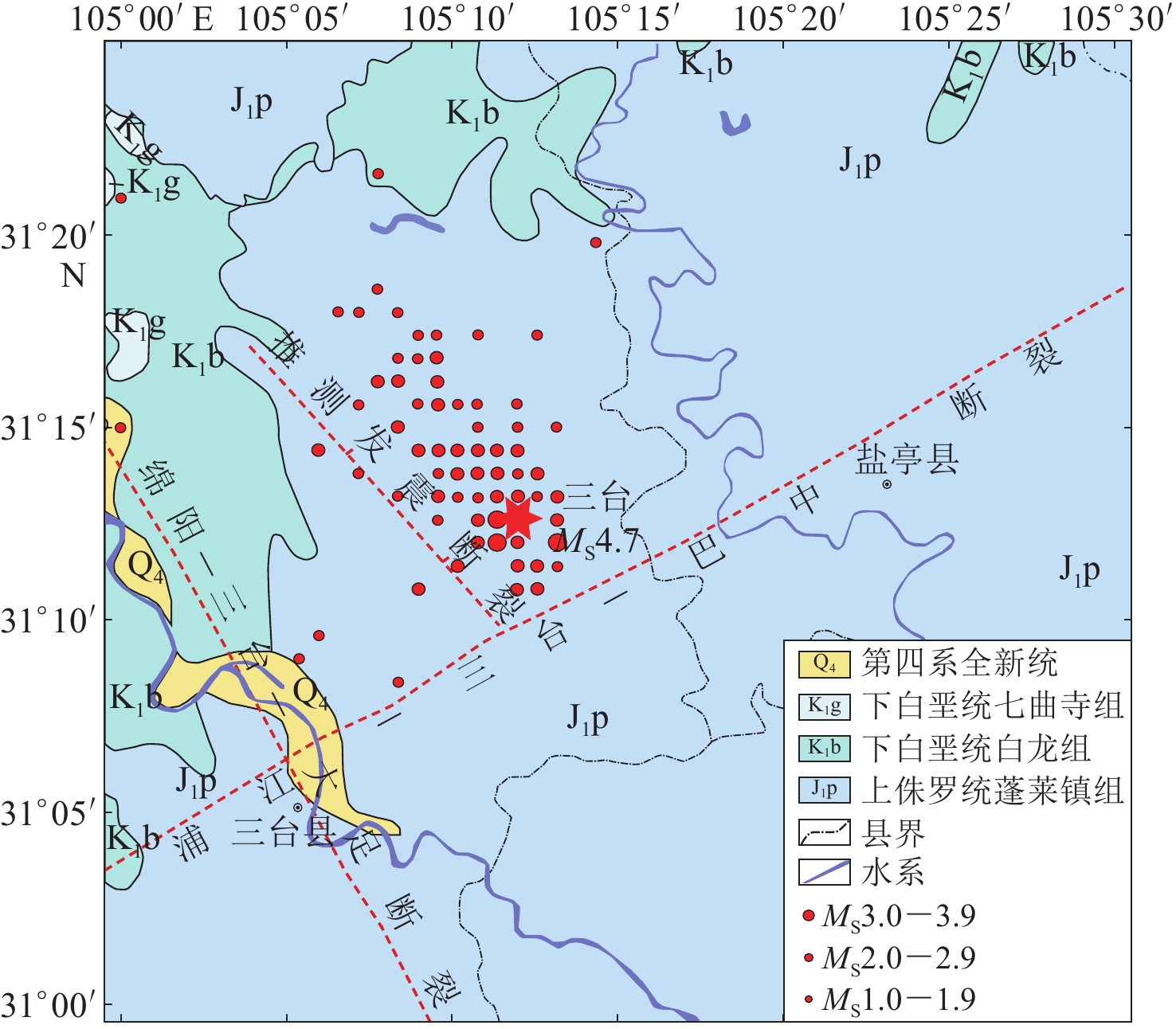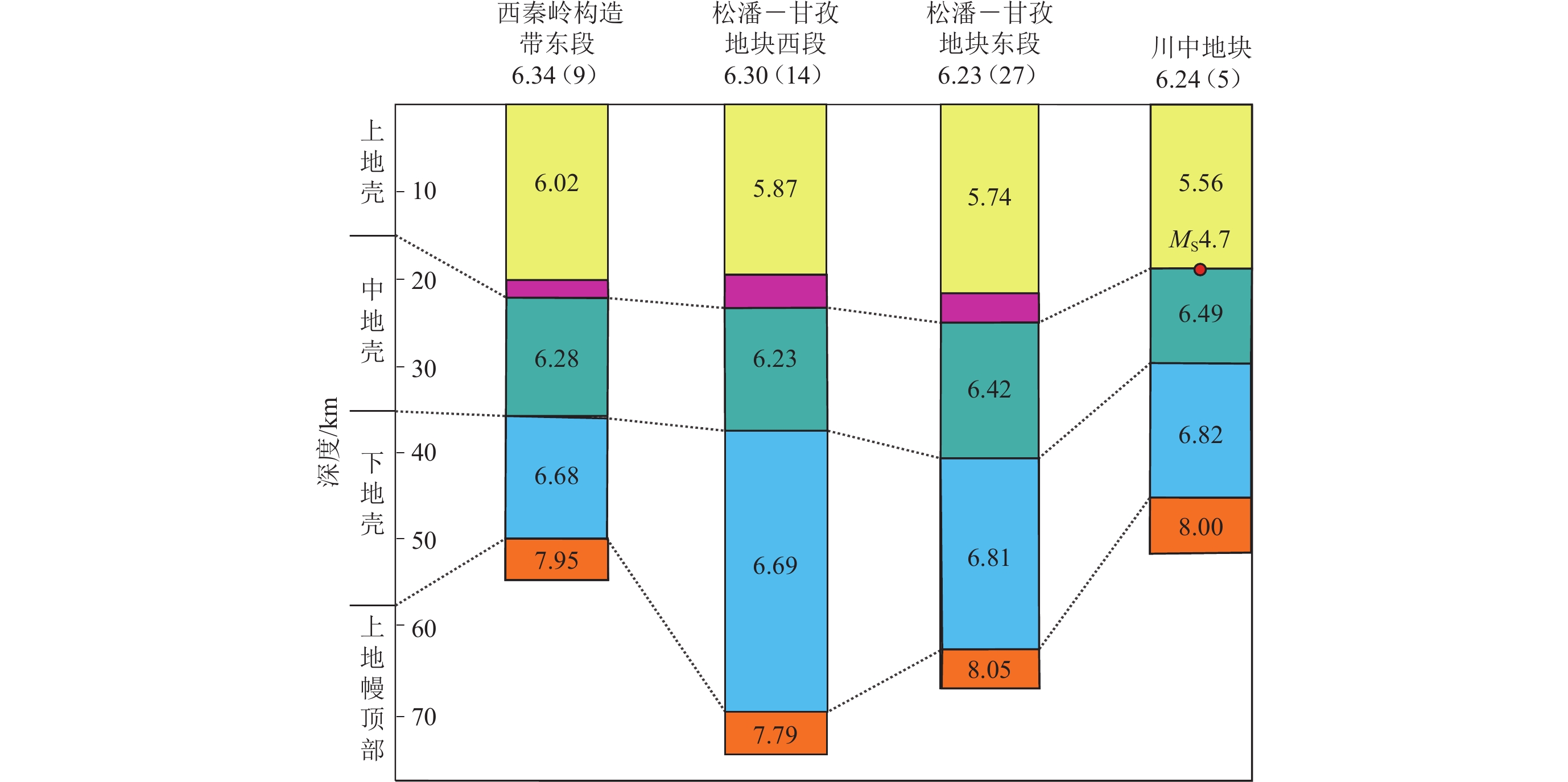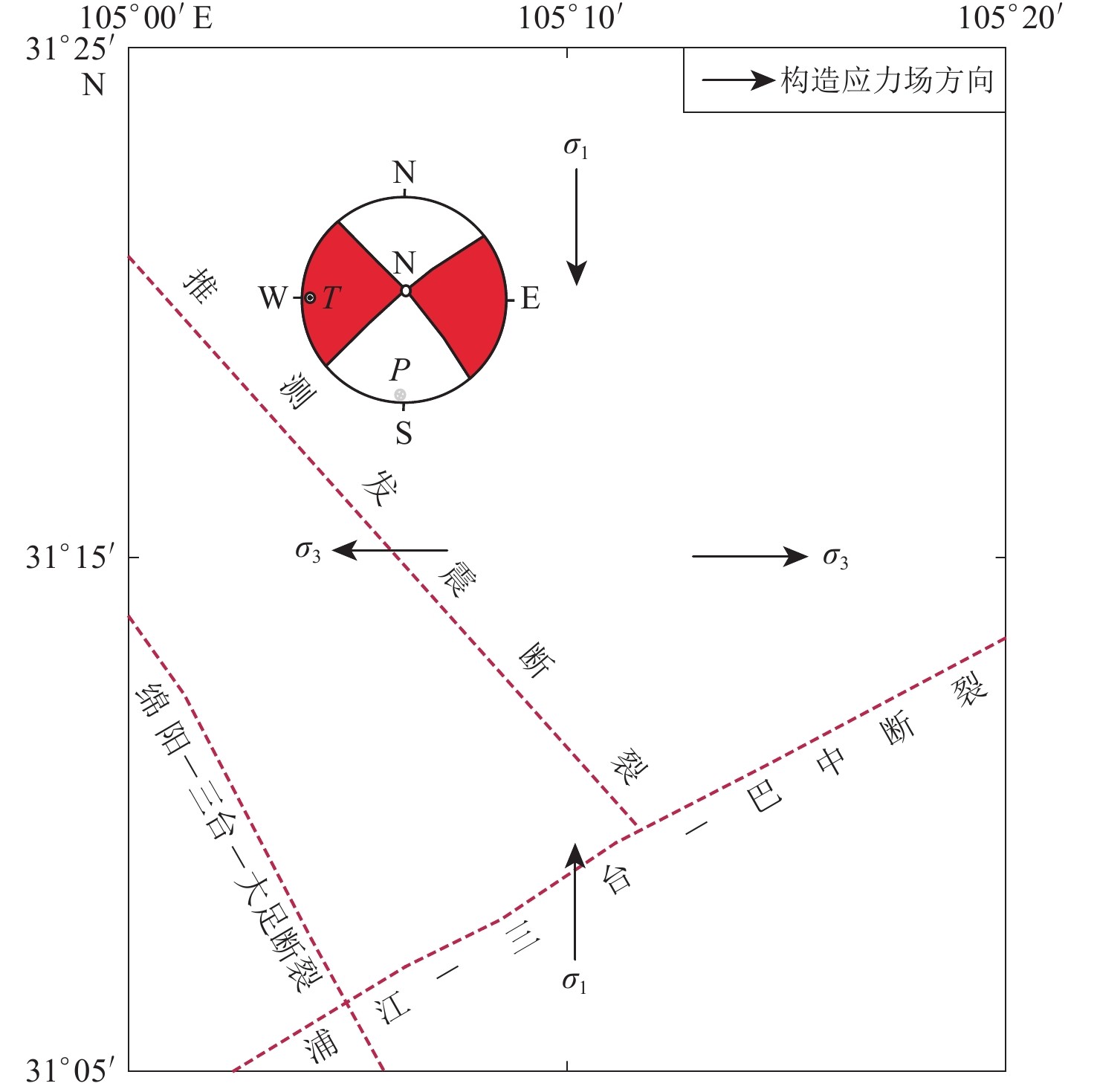Study on earthquake focal mechanism and seismogenic structure of the Santai MS4.7 earthquake in 2013
-
摘要: 2013年2月19日四川省绵阳市三台县发生MS4.7地震,震中位于四川盆地中部基底断裂绵阳—三台—大足断裂与蒲江—三台—巴中断裂的交会区域。基于地震目录、震相报告和波形等资料,对地震序列进行重定位,采用近远震联合波形反演求解主震震源机制,结合野外地质调查对该地震的发震构造进行分析。余震序列重定位的空间展布方向为NW-SE向,与节面Ⅰ走向吻合,认为此次地震发震断裂走向为NW−SE,倾向为NE,且破裂面近于直立,发震断层在近NS向的近水平挤压应力作用下作右旋走滑错动。实地调查中未见地表破裂及地表断层行迹,认为发震构造为一隐伏断裂。重定位及通过近远震联合反演所得震源深度分别为21.6和19 km,震源深度反映震源区位于上地壳底部的低速层内。此次地震可能是汶川地震造成的区域构造应力场改变与调整过程中,四川盆地川中地块内隐伏于前震旦纪结晶基底中的高角度断裂重新活动的结果。Abstract: Santai MS4.7 earthquake occurred in Mianyang city, Sichuan Province on February 19, 2013. The epicenter located in an intersection area which combined the basement fracture in central Sichuan basin, the Mianyang-Santai-Dazu fracture and the Pujiang-Santai-Bazhong fracture. Based on the earthquake catalogue, seismic phase report and waveform data, we relocated the earthquake sequence, and solved the focal mechanism of the main earthquake by joint inversion of local and teleseismic waveforms, and also studied the seismogenic structure of the Santai MS4.7 earthquake according to the field geological survey. The spatial distribution direction of the relocated aftershock sequence is NW-SE and it highly fitted with the nodal plane I of the focal mechanism, the seismogenic structure of the earthquake can be considered as strike NW-SE, dip NE, and rupture plane is nearly vertical, and the seismogenic fracture was dextral strike-slip dislocation by the proximately horizontal confining pressure in the direction of nearly NS. During the field survey, any fracture marks nor surface ruptures can be obviously found, hence the seismic structure is concluded as a buried fault. The focal depths are 21.6 and 19 km respectively through the relocation and joint inversion of local and teleseismic waveforms. The focal depth reflects that the location of the source area is in the low-velocity layer which is in the bottom of the upper-crust. This earthquake is caused during the adjusted and changed process of the tectonic stress field caused by Wenchuan earthquake, and it is the result of the reactivation of the high-angle fault concealed in the Presinian crystalline substrate in middle-block of Sichuan basin.
-
Keywords:
- Santai MS4.7 earthquake /
- focal mechanism /
- seismogenic structure /
- buried fault
-
引言
“5·12”汶川地震后,一些科研人员研究指出,汶川地震造成的区域应力场改变与调整可能会导致四川盆地地震危险性的增加(Parsons et al,2008;阮祥等,2010;Lu et al,2011;宫悦等,2013;艾依飞,张健,2019;易桂喜等,2019,2020)。事实证明,汶川地震后四川盆地内中强地震比较活跃,相继发生了一系列MS4.0—5.5地震,例如2008年10月10日自贡MS4.1地震、2009年6月30日什邡MS5.5地震、2009年11月28日彭州MS5.0地震、2010年1月31日遂宁MS5.0地震、2013年2月19日三台MS4.7地震、2014年7月29日梓潼MS4.9地震、2015年1月14日金口河MS5.0地震等。
据中国地震台网测定,2013年2月19日22时17分43.4秒四川省绵阳市三台县与盐亭县交界处发生MS4.7地震,震中位置为(31.21°N,105.20°E),震源深度约为20 km。地震造成了20多户农房受损,无人员伤亡。三台地震区为弱地震活动区,本次地震为该区有地震记录以来发生的最大地震(吕锦雄等,2016;易桂喜等,2019,2020;赵博等,2019),且震区为地震研究空白区。所以,研究本次地震的发震构造、分析其是汶川“5·12”震后应力的调制震还是新构造活动所致及震区的构造应力场等,可为该区地震危险性评估、地震灾害研究与区划及防震减灾等工作提供参考。
在地震序列重定位和主震震源机制解分析的基础上,结合断层地表行迹或区域构造背景研究地震的发震构造在国内外都得到了广泛的应用(吕坚等,2008,2011;张项,2010;刘泽民等,2015;易桂喜等,2015,2016a,2017a;李翠平等,2019)。本文拟通过地震序列重定位和主震震源机制解的分析(吕锦雄,2017),结合野外地质调查和震区地质构造特征对此次地震的发震构造及发震机理进行初步研究。
1. 研究区地质简况
三台县域地势北高南低,海拔高度约为307—672 m,地貌属川中丘陵区,属于扬子准地台西北部的川中凹陷低缓构造区,为新华夏第三沉积带的川北台凹构造体系(吕锦雄,2017),地质构造简单,主要由褶皱构造组成;出露地层主要为侏罗系、白垩系及第四系,其中第四系地层主要分布在河流两岸及沟谷低洼处;基岩主要为黄褐色、紫红色和黄色中-厚层状或薄层状砂岩或泥质砂岩以及紫红色、紫褐色和灰色薄-中层状泥岩。基岩节理较发育,节理走向无明显的优势分布方向(图1)。震中附近断层有梓潼—三台断裂、绵阳—三台—大足断裂及蒲江—三台—巴中断裂。梓潼—三台断裂由李明欣(2013)通过遥感解译提出,该断裂贯穿研究区,呈近NS向展布,长度约为75.9 km,断裂性质不明;绵阳—三台—大足断裂走向约为330°,长度约为31.6 km,断裂性质不明;蒲江—三台—巴中断裂走向约为60°,长度约为56.2 km,断裂性质不明。绵阳—三台—大足断裂及蒲江—三台—巴中断裂为区域性基底大断裂(宋鸿彪,罗志立,1995;罗志立,1998;艾依飞,张健,2019)。
![]() 图 1 研究区构造背景(引自李明欣,2013)F1:汶川—青川断裂;F2:映秀—北川断裂;F3:香水断裂;F4:二郞庙断裂;F5:古城断裂;F6:平武—青川断裂;F7:茂汶断裂;F8:黄土梁断裂;F9:龙泉山断裂;F10:永兴断裂;F11:青莲场断裂;F12:梓潼—三台断裂;F13:岷江断裂;F14:黑水断裂;F15:高生庙断裂Figure 1. The tectonic background of the studied area (after Li,2013)F1:Wenchuan-Qingchuan fault; F2:Yingxiu-Beichuan fault; F3:Xiangshui fault; F4:Erlangmiao fault; F5:Gucheng fault; F6:Pingwu-Qingchuan fault; F7:Maowen fault; F8:Huangtuliang fault; F9:Longquanshan fault; F10:Yongxing fault; F11:Qinglianchang fault; F12:Zitong-Santai fault; F13:Minjiang fault; F14:Heishui fault; F15:Gaoshengmiao fault
图 1 研究区构造背景(引自李明欣,2013)F1:汶川—青川断裂;F2:映秀—北川断裂;F3:香水断裂;F4:二郞庙断裂;F5:古城断裂;F6:平武—青川断裂;F7:茂汶断裂;F8:黄土梁断裂;F9:龙泉山断裂;F10:永兴断裂;F11:青莲场断裂;F12:梓潼—三台断裂;F13:岷江断裂;F14:黑水断裂;F15:高生庙断裂Figure 1. The tectonic background of the studied area (after Li,2013)F1:Wenchuan-Qingchuan fault; F2:Yingxiu-Beichuan fault; F3:Xiangshui fault; F4:Erlangmiao fault; F5:Gucheng fault; F6:Pingwu-Qingchuan fault; F7:Maowen fault; F8:Huangtuliang fault; F9:Longquanshan fault; F10:Yongxing fault; F11:Qinglianchang fault; F12:Zitong-Santai fault; F13:Minjiang fault; F14:Heishui fault; F15:Gaoshengmiao fault2. 地震序列分析
2.1 地震基本参数
地震发生后,四川省区域地震台网、中国地震台网中心和哈佛大学等给出了本次地震的基本参数(表1)。
表 1 三台地震参数Table 1. The parameters of the Santai earthquake发震时刻(北京时间) 北纬/° 东经/° 深度/km MS 数据来源 年-月-日 时:分:秒 2013-02-19 22:17:41.42 31.21 105.20 29.0 5.1 四川省区域地震台网 2013-02-19 22:17:43.40 31.21 105.20 20.0 4.7 中国地震台网中心 2013-02-19 22:17:44.60 31.18 105.26 19.6 4.9 哈佛大学全球矩心矩张量解 2.2 地震序列空间分布特征
精确的地震定位能准确地反映地震序列的空间分布特征,可为判断地震成因提供帮助(易桂喜等,2015,2017b;张丽芬等,2016;祁玉萍等,2018;李翠平等,2019)。地震序列重定位选用距离震中较近的安县数字化地震台网(区域台网)提供的多个地震台站(图2)记录的地震波形资料,选择信噪比高且方位角分布较好的4个以上台站,采用四川省地震局研发的数字化地震处理软件SeisDPS的区域模型搜索法,对三台MS4.7地震的前震、主震及余震进行重定位与分析。
地震序列重定位后EW向,NS向和垂向的定位精度分别为0.8,0.7和12 km,主震震源位置为(31.22°N,105.21°E),深度为21.6 km。地震序列震中分布如图3a所示。
由图3a可知,余震序列长轴沿NW-SE方向展布,长轴约为18.3 km,短轴约为11.3 km,主震NW侧余震明显多于SE侧,且较大余震主要集中在主震附近。根据余震序列的空间展布可判断三台地震的发震构造为NW-SE走向。
地震序列的震源位置和余震深度的展布可以反映主震发震断层的几何形态,也可为探索地震孕育、发生的深部环境提供依据(Wu,Takeo,2004)。地震序列震源深度沿剖面AA′和剖面BB′的分布如图3b,c所示。从地震序列深度剖面可以看出,余震的深度主要为5—25 km,分布较分散,绝大多数的余震较主震浅,说明破裂面以向上部扩展为主。剖面AA′显示主震SE侧余震数目远少于NW侧,说明NW方向为地震序列扩展的优势方向。剖面BB′反映沿断层倾向震源分布较分散。
3. 震源机制解分析
利用震源机制解分析地震的成因和了解地震发生时震源部位的应力状态及运动学特征,有助于理解发震构造条件(杜龙等,2009;罗艳等,2015;吕锦雄等,2016;易桂喜等,2016b,2017b;李翠平等,2019;李君,2019)。很多科研人员曾采用近远震联合波形反演法求解了主震震源机制(黄建平等,2009;谢祖军等,2013;郑建常等,2013;吕锦雄,2017;朱冰清等,2019)。通常近场记录由于受地壳速度结构模型的影响较小,对震源性质更敏感,反演的震源机制更准确;而远场所记录的数据包含了pP,sP,sS和pS等深度震相的信息,对于中强地震的深度约束更好。因此,利用近远场的波形数据反演得到的震源机制解参数更加可靠(吕锦雄,2017)。近震波形数据由安县地震台网提供,远震数据来自美国地震学研究联合会(Incorporated Research Institutions for Seismology,缩写为IRIS)网站,取震中距在30°—90°之间和信噪比较高的波形数据,远震台站信息列于表2。地壳速度模型采用绵阳市地震局编著的《绵阳市及邻区地震分布规律研究》(杨恒书等,2016)一书中提到的四川地区地壳结构模型(表3)。近远震联合反演的误差-深度分布及主震震源机制解见表4及图4,最佳深度约为19 km,与重定位深度接近,矩震级为MW4.88。
表 2 远震台站统计表Table 2. Statistical table of remote seismic stations台站名 方位角/° 震中距/° 纬度/° 东经/° 台站名 方位角/° 震中距/° 纬度/° 东经/° HKPS 136.36 11.94 22N 114 KIEV 313.46 57.87 51N 29 KBS 347.20 60.05 79N 12 UOSS 274.40 43.39 25N 56 PET 44.16 43.87 53N 159 DGAR 224.74 49.78 7S 72 ARU 322.04 40.87 56N 59 COCO 191.88 44.16 12S 97 TIXI 10.79 42.36 72N 129 GUMO 106.82 40.34 14N 145 表 3 地壳速度模型参数表Table 3. Table of crustal velocity model parameters名称 深度/km P波速度/(km·s−1) 名称 深度/km P波速度/(km·s−1) 第1层 5 5.86 第4层 23 5.9 第2层 14 6.00 第5层 36 6.6 第3层 21 6.30 第6层 40 7.1 表 4 三台地震主震震源机制解参数Table 4. Parameters of focal mechanism solution for the mainshock of Santai earthquake sequence节面Ⅰ 节面Ⅱ P 轴 T 轴 N 轴 来源 走向/° 倾角/° 滑动角/° 走向/° 倾角/° 滑动角/° 方位/° 倾角/° 方位/° 倾角/° 方位/° 倾角/° 320 83 −175 230 85 −5 182 4 274 5 30 85 本文 316 82 −177 226 87 −8 181 7 271 3 27 82 哈佛大学 ![]() 图 4 近远震联合反演的误差-深度分布图及主震震源机制解(a) 误差-深度分布图;(b) 本文所得震源机制解;(c) 哈佛大学给出的震源机制解Figure 4. Misfit variation with focal depth using CAP joint method and focal mechanism solutions of the mainshock(a) Error-depth distribution diagram;(b) The focal mechanism solution obtained in this study; (c) The focal mechanism solution given by Harvard University
图 4 近远震联合反演的误差-深度分布图及主震震源机制解(a) 误差-深度分布图;(b) 本文所得震源机制解;(c) 哈佛大学给出的震源机制解Figure 4. Misfit variation with focal depth using CAP joint method and focal mechanism solutions of the mainshock(a) Error-depth distribution diagram;(b) The focal mechanism solution obtained in this study; (c) The focal mechanism solution given by Harvard University从表4和图4b,c可以看出,本文得到的三台地震主震震源机制与美国哈佛大学依据全球远场波形反演的震源机制十分接近。
单次地震震源机制解的主轴与该地震释放的应力有关(Mckenzie,1969;Raleigh et al,1972;刘泽民等,2015),即只反映本次地震产生时的构造作用力。由表4及图4中的P,T轴方位角可知,震源区构造应力场的主压应力轴为近NS向,主张应力轴为近EW向,反映产生本次地震的构造作用力与秦启荣等(2005)提出的川中地区NS向挤压的区域构造应力场特征基本一致(吕锦雄,2017);由P,T轴的仰角可知,震源区的构造应力场近于水平,与成尔林(1981)、许忠淮等(1987)、蒋良文(1999)、马文涛等(2011)、曹颖等(2012)和李君等(2019)提出的四川盆地内区域构造应力场基本一致(吕锦雄,2017);N轴倾角很大,说明断裂水平剪切错动。震源机制解两个节面的倾角都较陡,说明此次地震的发震构造近于直立。
4. 发震构造与发震机理分析
三台地震主震震源机制解(表4、图4)中的NW-SE向节面 Ⅰ 与重定位后的余震序列空间展布长轴方向一致,且在地震序列震中分布图(图3)中沿节面 Ⅰ 即剖面AA′的走向320°看去,主震东侧的余震多于西侧,这与断层上盘余震多于下盘余震的上盘效应现象相吻合(毛玉平,万登堡,2001;俞言祥,高孟潭,2001;何仲太等,2012;吕锦雄等,2016;罗全波等,2019),从而推断主震震源机制解中的节面Ⅰ为发震断裂面,即发震断层走向为NW-SE向,倾向为NE,倾角陡直,为有微小张性分量的右旋走滑型断裂。结合节面Ⅰ倾角83°及重定位后主震震源深度21.6 km,经计算地震的发震构造从主震震中SW侧约2.65 km处通过。对该带进行野外地质调查,调查中未见地表破碎带或显著的断层迹象,且研究区的节理走向无明显的优势方向,所以认为发震断裂可能为隐伏性构造。研究区有区域性基底大断裂通过,此次地震发生于绵阳—三台—大足断裂与蒲江—三台—巴中断裂的交会处(图5)。绵阳—三台—大足断裂与蒲江—三台—巴中断裂为四川盆地内部存在的基底深断裂,它们与其它深断裂将四川盆地基底分割成众多的或大或小的菱形块体,对四川盆地不同时期的构造演化,特别是晚中生代以后的构造格局的改造与发展有着重要影响(宋鸿彪,罗志立,1995;罗志立,1998;艾依飞,张健,2019)。本次三台地震序列的余震空间分布呈NW-SE向,且震源机制解的节面Ⅰ走向为320°,与绵阳—三台—大足断裂的走向非常接近且断裂性质相似,但此断裂与震源区相隔较远,距离大于15 km,与震源区位置无明显衔接;而蒲江—三台—巴中断裂呈NE-SW走向,与此次地震余震区长轴走向不符。可见,发震构造没有明显已知构造与其对应,据此推断可能为未知隐伏构造。
震源深度是地震学研究的关键参数,也是目前难以准确测定的参数,精确测定震源深度有助于了解地震活动与断层之间的关系(张帆等,2017,2019)。四川盆地内发生的与逆断层伴生的背斜构造有关的中强地震,具有震级低、震源浅的特点:例如1962年洪雅MS5.1地震,震源深度为5 km;1967年仁寿MS5.5地震,震源深度为4 km;1985年自贡MS4.6地震,震源深度为5 km;1989年重庆江北MS5.4地震,震源深度为5 km,这些地震震源深度位于沉积盖层内的弱岩层滑脱面之上(钱洪等,1992;黄圣睦等,2003),且背斜和逆断层常同步消失于地下3—6 km的低强度的砂页岩和泥岩的岩石中(钱洪,1995;周荣军等,2005);蔡学林和曹家敏等(1998)研究认为盆地内构造变形主要沿基底与盖层间滑脱面以上5—10 km的沉积岩层发育,其变形构造为薄皮构造(张维宸,2009),该薄皮构造控制了盆地内地震震源深度。钱洪和唐荣昌(1992)研究认为作用于四川盆地的微弱现代构造应力场不足以推动盆地中的基底断裂,不会发生由于基底断裂的强烈断错而诱发强烈破坏性地震。但“5·12”汶川地震后,盆地内的中强地震明显增加,且震源深度都较大,例如遂宁MS5.0地震震源深度为10 km (Lu et al,2011);金口河MS5.0地震震源深度为12 km (马超等,2017)等。从震源深度来看作者认为这两次地震也还是发生于盆地内基底与盖层间的滑脱面上或其上部。但也有发生于盆地基底断裂中的地震:如彭州MS5.0地震震源深度为21 km (黄闻等,2010);梓潼MS4.9地震震源深度为21 km (吕锦雄等,2016)。本研究中的三台地震震源深度重定位结果为21.6 km,震源区位于盆地内川中地块上地壳底部的低速层内(图6),川中上地壳底部有厚约6 km的低速层,可能由花岗质的糜棱岩层组成,是具有塑性的滑脱层(罗志立,1998;张维宸,2009)。从震源深度来说,本文结果与罗钧等(2014)、李君等(2019)认为的四川盆地内地震大都发生在15—30 km深度的观点相吻合。
![]() Figure 6. Model for the crust thickness and velocity structure (Cai et al,2008,2010). The data in parentheses is the mean of participating,and the dotted line represents the low velocity layer in the crust
Figure 6. Model for the crust thickness and velocity structure (Cai et al,2008,2010). The data in parentheses is the mean of participating,and the dotted line represents the low velocity layer in the crust周缘造山带应力状态发生重大变化导致四川盆地内部构造应力场的变化与调整,使盆地盖层断层与基底断裂及其次级断裂附近应力集中,增大了盆地内发生中强地震的可能性,作者认为发生于汶川地震后,震源深度大于20 km的中强地震应为四川盆地基底断裂重新活动的反映。已有研究表明四川盆地内区域构造应力场为近NS向的近水平挤压和近EW向的近水平拉张(成尔林,1981;许忠淮等,1987;蒋良文,1999;秦启荣,2005;马文涛等,2011;曹颖等,2012;李君等,2019)。盆地内区域应力场的最大主压应力轴方位角与本次地震推测发震断裂走向夹角约为40°,而最小主压应力轴方位角与推测发震断裂的走向夹角约为50°。在此区域应力场的作用下,发震断裂的摩擦阻力较小,而张性右旋作用较大(刘泽民等,2015),从而基底断裂发生张性右旋走滑错动,此结果与主震的震源机制解亦吻合较好(图7)。
5. 讨论与结论
汶川地震后,四川盆地内中强地震活动变得活跃。三台地震震级较小,无法得到有明显方向性的地震动衰减等震线图。利用地震目录、震相报告和波形等相关资料对三台地震的地震序列、主震震源机制解及发震构造等方面进行研究,并初步分析其发震机理,获得如下认识:
1) 根据主震震源机制解及地震序列重定位结果,该地震是发生在四川盆地内的一次有微小张性分量的右旋走滑破裂事件;
2) 发震构造无明显已知构造与其对应,可能为未知隐伏构造,发震断裂走向为NW-SE,倾向为NE,倾角近于直立;
3) 三台地震是在四川盆地近NS向的近水平挤压和近EW向的近水平拉张作用的区域构造应力场作用下,汶川地震造成的区域构造应力场改变与调整过程中,隐伏于前震旦纪结晶基底中的高角度断裂重新活动的结果。在区域构造应力作用下,活动断裂在四川盆地川中地块内的上地壳底部低速层活动,从而引发具有微小张性分量的走滑型地震事件。
绵阳市防震减灾局、安县防震减灾局及三台县防震减灾办公室在资料收集及野外工作中给予了大力支持,四川省地震台网、安县地震台站提供了地震资料及相关软件,作者在此一并表示感谢。
-
图 1 研究区构造背景(引自李明欣,2013)
F1:汶川—青川断裂;F2:映秀—北川断裂;F3:香水断裂;F4:二郞庙断裂;F5:古城断裂;F6:平武—青川断裂;F7:茂汶断裂;F8:黄土梁断裂;F9:龙泉山断裂;F10:永兴断裂;F11:青莲场断裂;F12:梓潼—三台断裂;F13:岷江断裂;F14:黑水断裂;F15:高生庙断裂
Figure 1. The tectonic background of the studied area (after Li,2013)
F1:Wenchuan-Qingchuan fault; F2:Yingxiu-Beichuan fault; F3:Xiangshui fault; F4:Erlangmiao fault; F5:Gucheng fault; F6:Pingwu-Qingchuan fault; F7:Maowen fault; F8:Huangtuliang fault; F9:Longquanshan fault; F10:Yongxing fault; F11:Qinglianchang fault; F12:Zitong-Santai fault; F13:Minjiang fault; F14:Heishui fault; F15:Gaoshengmiao fault
图 4 近远震联合反演的误差-深度分布图及主震震源机制解
(a) 误差-深度分布图;(b) 本文所得震源机制解;(c) 哈佛大学给出的震源机制解
Figure 4. Misfit variation with focal depth using CAP joint method and focal mechanism solutions of the mainshock
(a) Error-depth distribution diagram;(b) The focal mechanism solution obtained in this study; (c) The focal mechanism solution given by Harvard University
图 6 地壳厚度及速度结构模型(蔡学林等,2008,2010). 括号内数据为参加平均数,虚线表示壳内低速层
Figure 6. Model for the crust thickness and velocity structure (Cai et al,2008,2010). The data in parentheses is the mean of participating,and the dotted line represents the low velocity layer in the crust
表 1 三台地震参数
Table 1 The parameters of the Santai earthquake
发震时刻(北京时间) 北纬/° 东经/° 深度/km MS 数据来源 年-月-日 时:分:秒 2013-02-19 22:17:41.42 31.21 105.20 29.0 5.1 四川省区域地震台网 2013-02-19 22:17:43.40 31.21 105.20 20.0 4.7 中国地震台网中心 2013-02-19 22:17:44.60 31.18 105.26 19.6 4.9 哈佛大学全球矩心矩张量解 表 2 远震台站统计表
Table 2 Statistical table of remote seismic stations
台站名 方位角/° 震中距/° 纬度/° 东经/° 台站名 方位角/° 震中距/° 纬度/° 东经/° HKPS 136.36 11.94 22N 114 KIEV 313.46 57.87 51N 29 KBS 347.20 60.05 79N 12 UOSS 274.40 43.39 25N 56 PET 44.16 43.87 53N 159 DGAR 224.74 49.78 7S 72 ARU 322.04 40.87 56N 59 COCO 191.88 44.16 12S 97 TIXI 10.79 42.36 72N 129 GUMO 106.82 40.34 14N 145 表 3 地壳速度模型参数表
Table 3 Table of crustal velocity model parameters
名称 深度/km P波速度/(km·s−1) 名称 深度/km P波速度/(km·s−1) 第1层 5 5.86 第4层 23 5.9 第2层 14 6.00 第5层 36 6.6 第3层 21 6.30 第6层 40 7.1 表 4 三台地震主震震源机制解参数
Table 4 Parameters of focal mechanism solution for the mainshock of Santai earthquake sequence
节面Ⅰ 节面Ⅱ P 轴 T 轴 N 轴 来源 走向/° 倾角/° 滑动角/° 走向/° 倾角/° 滑动角/° 方位/° 倾角/° 方位/° 倾角/° 方位/° 倾角/° 320 83 −175 230 85 −5 182 4 274 5 30 85 本文 316 82 −177 226 87 −8 181 7 271 3 27 82 哈佛大学 -
艾依飞,张健. 2019. 鲜水河断裂带南北构造差异性的地球物理分析[J]. 地震学报,41(3):329–342. Ai Y F,Zhang J. 2019. Geophysical analysis on the tectonic difference between northern and southern segments of Xianshuihe fault zone[J]. Acta Seismologica Sinica,41(3):329–342 (in Chinese).
蔡学林,曹家敏. 1998. 四川盆地变形构造格局及其对地震活动的控制作用[J]. 四川地震,20(3):27–35. Cai X L,Cao J M. 1998. The deformed structures framework control function on earthquake in Scihuan basin[J]. Earthquake Research in Sichuan,20(3):27–35 (in Chinese).
蔡学林,曹家敏,朱介寿,程先琼. 2008. 龙门山岩石圈地壳三维结构及汶川大地震成因浅析[J]. 成都理工大学学报(自然科学版),35(4):357–365. doi: 10.3969/j.issn.1671-9727.2008.04.003 Cai X L,Cao J M,Zhu J S,Cheng X Q. 2008. A preliminary study on the 3-D crust structure for the Longmen lithosphere and the genesis of the huge Wenchuan earthquake,Sichuan,China[J]. Journal of Chengdu University of Technology (Science &Technology Edition)
,35(4):357–365 (in Chinese). 蔡学林,王绪本,朱介寿,曹家敏,程先琼,余年,张伟,鲁霞,庞溯,张振宇. 2010. 汶川8.0级特大地震震源断裂特征及其动力学分析[J]. 中国地质,37(4):952–966. doi: 10.3969/j.issn.1000-3657.2010.04.011 Cai X L,Wang X B,Zhu J S,Cao J M,Cheng X Q,Yu N,Zhang W,Lu X,Pang S,Zhang Z Y. 2010. Characteristics and geodynamic analysis of the focal fault for the great MS8.0 Wenchuan earthquake[J]. Geology in China,37(4):952–966 (in Chinese).
曹颖,吴小平,沈娅宏,李兆隆. 2012. 由震源机制解资料研究川滇地区构造应力场[J]. 地震研究,36(2):165–172. Cao Y,Wu X P,Shen Y H,Li Z L. 2012. Research on structural stress field basing on focal mechanism solutions data in Sichuan-Yunan area[J]. Journal of Seismological Research,36(2):165–172 (in Chinese).
成尔林. 1981. 四川及其邻区现代构造应力场和现代构造运动特征[J]. 地震学报,3(3):231–241. Cheng E L. 1981. Recent tectonic stress field and tectonic movement of the Sichuan Province and its vicinity[J]. Acta Seismologica Sinica,3(3):231–241 (in Chinese).
杜龙,周本刚,王明明. 2009. 2003年内蒙古巴林左旗MS5.9地震发震构造[J]. 中国地震,25(2):123–131. doi: 10.3969/j.issn.1001-4683.2009.02.002 Du L,Zhou B G,Wang M M. 2009. Seismogenic structure of 2003 Bailinzuoqi MS5.9 earthquake in Inner Mongolia,China[J]. Earthquake Research in China,25(2):123–131 (in Chinese).
宫悦,易桂喜,龙峰. 2013. 梓潼地区地震活动异常调查[J]. 四川地震,(3):1–4. doi: 10.3969/j.issn.1001-8115.2013.03.001 Gong Y,Yi G X,Long F. 2013. Investigation on the seismicity anomaly in Zitong region[J]. Earthquake Research in Sichuan,(3):1–4 (in Chinese).
何仲太,马保起,李玉森,郝彦军,沙鹏. 2012. 汶川地震地表破裂带宽度与断层上盘效应[J]. 北京大学学报(自然科学版),48(6):886–894. He Z T,Ma B Q,Li Y S,Hao Y J,Sha P. 2012. Width and hanging wall effect of surface rupture caused by Wenchuan earthquake[J]. Acta Scientiarum Naturalium Universitatis Pekinensis,48(6):886–894 (in Chinese).
黄建平,倪四道,傅容珊,钮凤林,邵志刚,郑勇. 2009. 综合近震及远震波形反演2006文安地震(MW5.1)的震源机制解[J]. 地球物理学报,52(1):120–130. Huang J P,Ni S D,Fu R S,Niu F L,Shao Z G,Zheng Y. 2009. Source mechanism of the 2006 MW5.1 Wen’an earthquakedetermined from a joint inversion of local and teleseismic broadband waveform data[J]. Chinese Journal of Geophysics,52(1):120–130 (in Chinese). doi: 10.1002/cjg2.1333
黄圣睦,何天华,范明祥,黎家盆,谢雄飞,方和弟,武至慎. 2003. 从石油人工地震资料分析成都平原地震地质背景的新认识[J]. 地震地质,25(4):581–594. doi: 10.3969/j.issn.0253-4967.2003.04.007 Huang S M,He T H,Fan M X,Li J P,Xie X F,Fang H D,Wu Z S. 2010. Possible precursory anomalies before the 2010 Dujiangyan-Pengzhou M5.0 earthquake[J]. Earthquake Research in Sichuan,(4):30–35 (in Chinese).
黄闻,徐水森,章旭玲,毕晓佳,徐华全. 2010. 四川都江堰、彭州5级地震前兆异常初探[J]. 四川地震,(4):30–35. doi: 10.3969/j.issn.1001-8115.2010.04.006 Huang W,Xu S S,Zhang X L,Bi X J,Xu H Q. 2010. Possible precursory anomalies before the 2010 Dujiangyan-Pengzhou M5.0 earthquake[J]. Earthquake Research in Sichuan,(4):30–35 (in Chinese).
蒋良文. 1999. 泯江上游活动断裂及主要地质灾害研究[D]. 成都: 成都理工大学: 58–64. Jiang L W. 1999. Research on Active Faults and Major Geological Hazards in the Upstream of Min River[D]. Chengdu: Chengdu University of Technology: 58–64 (in Chinese).
李翠平,唐茂云,郭卫英,黄世源,王小龙,高见. 2019. 2017年11月23日重庆武隆MS5.0地震序列重定位及发震断层分析[J]. 地震地质,41(3):603–618. doi: 10.3969/j.issn.0253-4967.2019.03.005 Li C P,Tang M Y,Guo W Y,Huang S Y,Wang X L,Gao J. 2019. Relocation of the 23 November 2017 Wulong MS5.0 earthquake sequence and analysis of its seismogenic fault[J]. Seismology and Geology,41(3):603–618 (in Chinese).
李君,王勤彩,崔子健,张佩,周琳,周辉. 2019. 川滇菱形块体东边界及邻区震源机制解与构造应力场空间分布特征[J]. 地震地质,41(6):1395–1412. doi: 10.3969/j.issn.0253-4967.2019.06.006 Li J,Wang Q C,Cui Z J,Zhang P,Zhou L,Zhou H. 2019. Characteristics of focal mechanisms and stress field in the eastern boundary of Sichuan-Yunnan block and its adjacent area[J]. Seismology and Geology,41(6):1395–1412 (in Chinese).
李明欣. 2013. 遥感技术在龙门山北段盆山耦合带的应用[D]. 绵阳: 西南科技大学: 58–60. Li M X. 2013. Application of Remote Sensing Technology in Basin-mountain Coupling in the Northern Part of Longmen Mountain[D]. Mianyang: Southwest University of Science and Technology: 58–60 (in Chinese).
刘泽民,黄显良,倪红玉,张炳,骆佳骥,王琐琛. 2015. 2014年4月20日霍山MS4.3地震发震构造研究[J]. 地震学报,37(3):402–410. doi: 10.11939/j.issn:0253-3782.2015.03.003 Liu Z M,Huang X L,Ni H Y,Zhang B,Luo J J,Wang S C. 2015. Seismogenic structure of the 20 April 2014 Huoshan MS4.3 earthquake in Auhui region[J]. Acta Seismologica Sinica,37(3):402–410 (in Chinese).
罗钧,赵翠萍,周连庆. 2014. 川滇块体及周边区域现今震源机制和应力场特征[J]. 地震地质,36(2):405–421. doi: 10.3969/j.issn.0253-4967.2014.02.011 Luo J,Zhao C P,Zhou L Q. 2014. Characteristics of focal mechanisms and stress field of the Chuan-Dian rhombic block and its adjacent regions[J]. Seismology and Geology,36(2):405–421 (in Chinese).
罗全波,陈学良,高孟潭,李宗超,李铁飞. 2019. 近断层速度脉冲地震动的三维有限差分模拟[J]. 地震工程学报,41(6):1630–1636. doi: 10.3969/j.issn.1000-0844.2019.06.1630 Luo Q B,Chen X L,Gao M T,Li Z C,Li T F. 2019. Three-dimensional finite-difference simulation of near-fault velocity pulse-like ground motions[J]. China Earthquake Engineering Journal,41(6):1630–1636 (in Chinese).
罗艳,赵里,曾祥方,高原. 2015. 芦山地震序列震源机制及其构造应力场空间变化[J]. 中国科学:地球科学,45(4):538–550. Luo Y,Zhao L,Zeng X F,Gao Y. 2015. Focal mechanisms of the Lushan earthquake sequence and spatial variation of the stress field[J]. Science China Earth Sciences,58(7):1148–1158. doi: 10.1007/s11430-014-5017-y
罗志立. 1998. 四川盆地基底结构的新认识[J]. 成都理工学院学报,25(2):191–200. Luo Z L. 1998. New recognition of basement in Sichuan basin[J]. Journal of Chengdu University of Technology,25(2):191–200 (in Chinese).
吕坚,郑勇,倪四道,高建华. 2008. 2005年11月26日九江—瑞昌MS5.7、MS4.8地震的震源机制解与发震构造研究[J]. 地球物理学报,51(1):158–164. doi: 10.3321/j.issn:0001-5733.2008.01.020 Lü J,Zheng Y,Ni S D,Gao J H. 2008. Focal mechanisms and seismogenic structures of the MS5.7 and MS4.8 Jiujiang-Ruichang earthquakes of Nov. 26,2005[J]. Chinese Journal of Geophysics,51(1):158–164 (in Chinese).
吕坚,郑勇,马玉虎,王晓山,尚荣波,苏金蓉,肖建华,郑斌. 2011. 2010年4月14日青海玉树MS4.7,MS7.1,MS6.3地震震源机制解与发震构造研究[J]. 地球物理学进展,26(5):1600–1606. doi: 10.3969/j.issn.1004-2903.2011.05.012 Lü J,Zheng Y,Ma Y H,Wang X S,Shang R B,Su J R,Xiao J H,Zheng B. 2011. Focal mechanisms and seismogenic structures of the MS4.7,MS7.1 and MS6.3 Yushu earthquakes of April 14,2010[J]. Progress in Geophysics,26(5):1600–1606 (in Chinese).
吕锦雄,刘岁海,李鹏飞,吴欢. 2016. 2014年7月29日梓潼MS4.9地震发震构造研究[J]. 地震工程与工程振动,36(4):185–191. Lü J X,Liu S H,Li P F,Wu H. 2016. Seismogenic structure of the Zitong MS4.9 earthquake of July 29,2014[J]. Earthquake Engineering and Engineering Vibration,36(4):185–191 (in Chinese).
吕锦雄. 2017. 梓潼“7.29”MS4.9地震发震构造研究[D]. 绵阳: 西南科技大学: 20–46. Lü J X, 2017, Seismogenic Structure of the Zitong MS4.9 earthquake of July 29[D]. Mianyang: University of Science and Technology: 20-46 (in Chinese)
马超,戈天勇,张威,汤才成. 2017. 乐山市金口河区5.0级地震结构震害特征[J]. 绵阳师范学院学报,36(2):79–86. doi: 10.3969/j.issn.1672-612X.2017.02.018 Ma C,Ge T Y,Zhang W,Tang C C. 2017. The damage characteristics of 5.0 magnitude earthquake structure in Jinkouhe Leshan[J]. Journal of Mianyang Teachers’College,36(2):79–86 (in Chinese).
马文涛,徐长朋,张新东,徐锡伟,李海鸥,苑京立. 2011. 紫坪铺水库与汶川地震关系的讨论[J]. 地震地质,33(1):175–190. doi: 10.3969/j.issn.0253-4967.2011.01.017 Ma W T,Xu C P,Zhang X D,Xu X W,Li H O,Yuan J L. 2011. Study on the relationship between the reservoir-induced seismicity at Zipingpu reservoir and the MS8.0 Wenchuan earthquake[J]. Seismology and Geology,33(1):175–190 (in Chinese).
毛玉平, 万登堡. 2001. 2000年云南姚安6.5级地震[M]. 昆明: 云南科技出版社: 95–98. Mao Y P, Wan D B. 2001. Yunnan Yaoan 6.5 earthquake in 2000[M]. Kunming: Yunnan Technology Press: 95–98 (in Chinese).
祁玉萍,龙锋,肖本夫,路茜,江鹏. 2018. 2017年九寨沟7.0级地震序列震源机制解和构造应力场特征[J]. 地球学报,39(5):622–634. doi: 10.3975/cagsb.2018.061901 Qi Y P,Long F,Xiao B F,Lu Q,Jiang P. 2018. Focal mechanism solutions and tectonic stress field characteristics of the 2017 MS7.0 Jiuzhaigou earthquake sequence[J]. Acta Geoscientica Sinica,39(5):622–634 (in Chinese).
钱洪,唐荣昌. 1992. 四川盆地的地震地质特征[J]. 四川地震,(3):13–18. Qian H,Tang R C. 1992. Seismo-geological features of the Sichuan basin[J]. Earthquake Research in Sichuan,(3):13–18 (in Chinese).
钱洪,唐荣昌,马声浩. 1992. 蒲江—新津—成都—德阳断裂带:成都平原内一条代表性弱活动地震带的地震地质特征[J]. 四川地震,(4):17–23. Qian H,Tang R C,Ma S H. 1992. The Pujiang-Xinjin-Chengdu-Deyang fault zone:The setsmo-geologic features of a representative seismic zone with weak activity in Chengdu plain[J]. Earthquake Research in Sichuan,(4):17–23 (in Chinese).
钱洪. 1995. 四川活动断裂对强震的控制作用[J]. 四川地震,(1):10–17. Qian H. 1995. Active faults control on strong earthquakes in Sichuan[J]. Earthquake Research in Sichuan,(1):10–17 (in Chinese).
秦启荣,苏培东,李乐,刘莉萍. 2005. 川中低缓构造成因[J]. 新疆石油地质,26(1):108–111. doi: 10.3969/j.issn.1001-3873.2005.01.032 Qin Q R,Su P D,Li L,Liu L P. 2005. Origin of low structures in central Sichuan area[J]. Xinjiang Petroleum Geology,26(1):108–111 (in Chinese).
阮祥,程万正,杜方,张致伟,刘丽芳,黄世源. 2010. 汶川8.0级地震前后四川及邻区构造应力场研究[J]. 中国地震,26(2):183–191. doi: 10.3969/j.issn.1001-4683.2010.02.006 Ruan X,Cheng W Z,Du F,Zhang Z W,Liu L F,Huang S Y. 2010. Research on the tectonic stress field in Sichuan and its adjacent areas before and after the Wenchuan MS8.0 earthquake[J]. Earthquake Research in China,26(2):183–191 (in Chinese).
宋鸿彪,罗志立. 1995. 四川盆地基底及深部地质结构研究的进展[J]. 地学前缘,2(3/4):231–237. Song H B,Luo Z L. 1995. The study of the basement and deep geological structures of Sichuan basin,China[J]. Earth Science Frontiers,2(3/4):231–237 (in Chinese).
谢祖军,金笔凯,郑勇,葛粲,熊熊,熊诚,许厚泽. 2013. 近远震波形反演2013年芦山地震震源参数[J]. 中国科学:地球科学,43(6):1010–1019. Xie Z J,Jin B K,Zheng Y,Ge C,Xiong X,Xiong C,Hsu H. 2013. Source parameters inversion of the 2013 Lushan earthquake by combining teleseismic waveforms and local seismograms[J]. Science China Earth Sciences,56(7):1177–1186. doi: 10.1007/s11430-013-4640-3
许忠淮,汪素云,黄雨蕊,高阿甲,金小锋,常向东. 1987. 由多个小震推断的青甘和川滇地区地壳应力场的方向特征[J]. 地球物理学报,30(5):476–486. doi: 10.3321/j.issn:0001-5733.1987.05.005 Xu Z H,Wang S Y,Huang Y R,Gao A J,Jin X F,Chang X D. 1987. Directions of mean stress axes in southwestern China deduced from microearthquake data[J]. Acta Geophysica Sinica,30(5):476–486 (in Chinese).
杨恒书,李明欣,何廷超. 2016. 龙门山盆-山耦合带遥感地质与地震[J]. 四川地震,(2):1–7. Yang H S,Li M X,He T C. 2016. Remote sensing geology and earthquakes along the coupling belt between Longmenshan mountain and Chengdu basin[J]. Earthquake Research in Sichuan,(2):1–7 (in Chinese).
易桂喜,龙锋,闻学泽,梁明剑,王思维. 2015. 2014年11月22日康定M6.3地震序列发震构造分析[J]. 地球物理学报,58(4):1205–1219. doi: 10.6038/cjg20150410 Yi G X,Long F,Wen X Z,Liang M J,Wang S W. 2015. Seismogenic structure of the M6.3 Kangding earthquake sequence on 22 Nov. 2014,southwestern China[J]. Chinese Journal of Geophysics,58(4):1205–1219 (in Chinese).
易桂喜,龙锋,赵敏,宫悦,张致伟,乔慧珍. 2016a. 2014年10月1日越西M5.0地震震源机制与发震构造分析[J]. 地震地质,38(4):1124–1136. doi: 10.3969/j.issn.0253-4967.2016.04.025 Yi G X,Long F,Zhao M,Gong Y,Zhang Z W,Qiao H Z. 2016. Focal mechanism and seismogenic structure of the M5.0 Yuexi earthquake on 1 Oct. 2014,southwestern China[J]. Seismology and Geology,38(4):1124–1136 (in Chinese).
易桂喜,龙锋,Vallage A,Klinger Y,梁明剑,王思维. 2016b. 2013年芦山地震序列震源机制与震源区构造变形特征分析[J]. 地球物理学报,59(10):3711–3731. doi: 10.6038/cjg20161017 Yi G X,Long F,Vallage A,Klinger Y,Liang M J,Wang S W. 2016. Focal mechanism and tectonic deformation in the seismogenic area of the 2013 Lushan earthquake sequence,southwestern China[J]. Chinese Journal of Geophysics,59(10):3711–3731 (in Chinese).
易桂喜,龙锋,梁明剑,张致伟,赵敏,祁玉萍,宫悦,乔慧珍,汪智,王思维,帅莉蓉. 2017a. 2016年9月23日四川理塘M4.9和M5.1地震发震构造分析[J]. 地震地质,39(5):949–963. doi: 10.3969/j.issn.0253-4967.2017.05.006 Yi G X,Long F,Liang M J,Zhang Z W,Zhao M,Qi Y P,Gong Y,Qiao H Z,Wang Z,Wang S W,Shuai L R. 2017. Seismogenic structure of the M4.9 and M5.1 Litang earthquakes on 23 September 2016 in southwestern China[J]. Seismology and Geology,39(5):949–963 (in Chinese).
易桂喜,龙锋,梁明剑,张会平,赵敏,叶有清,张致伟,祁玉萍,王思维,宫悦,乔惠珍,汪智,邱桂兰,苏金蓉. 2017b. 2017年8月8日九寨沟M7.0地震及余震震源机制解与发震构造分析[J]. 地球物理学报,60(10):4083–4097. doi: 10.6038/cjg20171033 Yi G X,Long F,Liang M J,Zhang H P,Zhao M,Ye Y Q,Zhang Z W,Qi Y P,Wang S W,Gong Y,Qiao H Z,Wang Z,Qiu G L,Su J R. 2017. Focal mechanism solutions and seismogenic structure of the 8 August 2017 M7.0 Jiuzhaigou earthquake and its aftershocks,northern Sichuan[J]. Chinese Journal of Geophysics,60(10):4083–4097 (in Chinese).
易桂喜,龙锋,梁明剑,赵敏,王思维,宫悦,乔慧珍,苏金蓉. 2019. 2019年6月17日四川长宁Ms6.0地震序列震源机制解与发震构造分析[J]. 地球物理学报,62(9):3432–3447. doi: 10.6038/cjg2019N0297 Yi G X,Long F,Liang M J,Zhao M,Wang S W,Gong Y,Qiao H Z,Su J R. 2019. Focal mechanism solutions and seismogenic structure of the 17 June 2019 MS6.0 Sichuan Changning earthquake sequence[J]. Chinese Journal of Geophysics,62(9):3432–3447 (in Chinese).
易桂喜,周龙泉,张浪平,龙锋,宫悦. 2020. 四川盆地内部少震与弱震区MS≥4.5地震预测意义分析[J]. 地震研究,43(2):262–269. doi: 10.3969/j.issn.1000-0666.2020.02.007 Yi G X,Zhou L Q,Zhang L P,Long F,Gong Y. 2020. Predictive efficiency tests of moderate earthquakes with sizes MS≥4.5 in low seismicity regions within Sichuan basin[J]. Journal of Seismological Research,43(2):262–269 (in Chinese).
俞言祥,高孟潭. 2001. 台湾集集地震近场地震动的上盘效应[J]. 地震学报,24(6):615–621. doi: 10.3321/j.issn:0253-3782.2001.06.007 Yu Y X,Gao M T. 2001. Effects of the hanging wall and footwall on peak acceleration during the Chi-Chi earthquake,Taiwan[J]. Acta Seismologica Sinica,24(6):615–621 (in Chinese).
张帆,韩晓明,郝美仙,李娟. 2017. 2016年5月22日辽宁朝阳4.6级地震震源机制和震源深度研究[J]. 中国地震,33(1):141–153. doi: 10.3969/j.issn.1001-4683.2017.01.014 Zhang F,Han X M,Hao M X,Li J. 2017. Focal mechanism and focal depth of the May 22,2016 MS4.6 earthquake in Chaoyang,Liaoning[J]. Earthquake Research in China,33(1):141–153 (in Chinese).
张帆,徐岩,宋晓燕,王磊,王树波. 2019. 用Pn-Pg走时差计算内蒙古地区地震震源深度[J]. 地震,39(1):81–89. doi: 10.3969/j.issn.1000-3274.2019.01.009 Zhang F,Xu Y,Song X Y,Wang L,Wang S B. 2019. Using Pg-Pn travel-time difference to calculate the focal depth in the Inner Mongolia area of China[J]. Earthquake,39(1):81–89 (in Chinese).
张丽芬,廖武林,李井冈,魏贵春,申学林. 2016. 2013年12月16日巴东M5.1地震序列及发震构造分析[J]. 地震地质,38(3):747–759. doi: 10.3969/j.issn.0253-4967.2016.03.019 Zhang L F,Liao W L,Li J G,Wei G C,Shen X L. 2016. Analysis on the 2013 Badong M5.1 earthquake sequence and the seismogenic structure[J]. Seismology and Geology,38(3):747–759 (in Chinese).
张维宸. 2009. 四川盆地中新生代区域构造格架与构造演化过程研究[D]. 北京: 中国地质大学(北京): 55–59. Zhang W C. 2009. Tectonic Framework and Tectonic Evolution of the Sichuan Basin in the Mesozoic and Cenozoic[D]. Beijing: China University of Geosciences (Beijing): 55–59 (in Chinese).
张项. 2010. 用初动P波波形反演中小地震震源机制解及其在首都圈地震震源反演中的初步应用研究[D]. 北京: 中国地震局地震预测研究所: 13–30. Zhang X. 2010. Solving for Focal Mechanisms of Small and Moderate Earthquakes Using Initial P Waveforms and its Preliminary Application for Source Reversion in Beijing Metropolitan Area[D]. Beijing: Institute of Earthquake Science, China Earthquake Administration: 13–30 (in Chinese).
赵博,高原,刘杰,梁姗姗,徐志国,杜广宝. 2019. 2010年以来四川地区中强地震震源机制反演及深度确定[J]. 地球物理学报,62(1):130–142. doi: 10.6038/cjg2019M0155 Zhao B,Gao Y,Liu J,Liang S S,Xu Z G,Du G B. 2019. Focal mechanism inversion and source depth locating of moderate-major earthquakes in the Sichuan region since 2010[J]. Chinese Journal of Geophysics,62(1):130–142 (in Chinese).
郑建常, 王鹏, 林眉, 穆娟, 徐长朋, 李冬梅. 2013. 区域全波形反演美国三次中强地震的震源矩张量[C]//2013年环渤海、泛珠三角洲地球物理论坛暨山东省地球物理学会成立十周年学术交流研讨会. 济南: 山东省地球物理学会, 广东省地球物理学会: 2825–2837. Zheng J C, Wang P, Lin M, Mu J, Xu C P, Li D M. 2013. Moment tensor inversion for 3 mid-strong earthquakes in U. S. using regional full waveforms[C]//2013 Bohai Rim and Pan-Pearl Delta Geophysical Forum and Academic Exchange Seminar on the 10th Anniversary of Shandong Geophysical Society. Ji’nan: Shandong Provence Geophysical Society, Guangdong Provence Geophysical Society: 2825–2837 (in Chinese).
周荣军, 李勇. 2013. 四川盆地西部的活动构造与地震: 以遂宁(MS5.0)地震为例[C]//第六届构造地质与地球动力学学术研讨会. 长春: 吉林大学: 44–45. Zhou R J, Li Y. 2013. Active tectonics and earthquakes in western Sichuan basin: A case study of Suining (MS5. 0) earthquake[C]//6th National Symposium on Structure Geology Geodynamics. Changchun: Jilin University: 44–45 (in Chinese).
周荣军,唐荣昌,雷建成. 2005. 四川盆地潜在震源区的细致划分[J]. 四川地震,(3):1–6. doi: 10.3969/j.issn.1001-8115.2005.03.001 Zhou R J,Tang R C,Lei J C. 2005. Attentive seismic hazard mapping for Sichuan basin[J]. Earthquake Research in Sichuan,(3):1–6 (in Chinese).
朱冰清,曹井泉,赵黎明,谭毅培,董一兵,王建国. 2019. 地震震源深度测定方法研究综述[J]. 内陆地震,33(4):321–329. Zhu B Q,Cao J Q,Zhao L M,Tan Y P,Dong Y B,Wang J G. 2019. Research summary on methods for determining focal depth of earthquakes[J]. Inland Earthquake,33(4):321–329 (in Chinese).
Lu R Q,He D F,Jokn S,Ma Y S,Guan S W,Sun Y P,Gao J W. 2011. The seismogenic structure of the 2010 Suining MS5.0 earthquake and its geometry,kinematics and dynamics analysis[J]. Acta Geologica Sinica-English Edition,85(6):1277–1285. doi: 10.1111/j.1755-6724.2011.00587.x
McKenzie D P. 1969. The relation between fault plane solutions for earthquakes and the directions of the principal stresses[J]. Bull Seismol Soc Am,59(2):591–601. doi: 10.1785/BSSA0590020591
Parsons T,Ji C,Kirby E. 2008. Stress changes from the 2008 Wenchuan earthquake and increased hazard in-the Sichuan basine[J]. Nature,454(7203):509–510.
Raleigh C B, Healy J H, Bredehoeft J D. 1972. Faulting and Crustal Stress at Rangeley, Colorado[M]. Washington, DC: AGU: 275–284.
Wu C J,Takeo M. 2004. An intermediate deep earthquake rupturing on a dip-bending fault:Waveform analysis of the 2003 Miyagi-ken Oki earthquake[J]. Geophys Res Lett,312(24):L24619.
-
期刊类型引用(0)
其他类型引用(1)




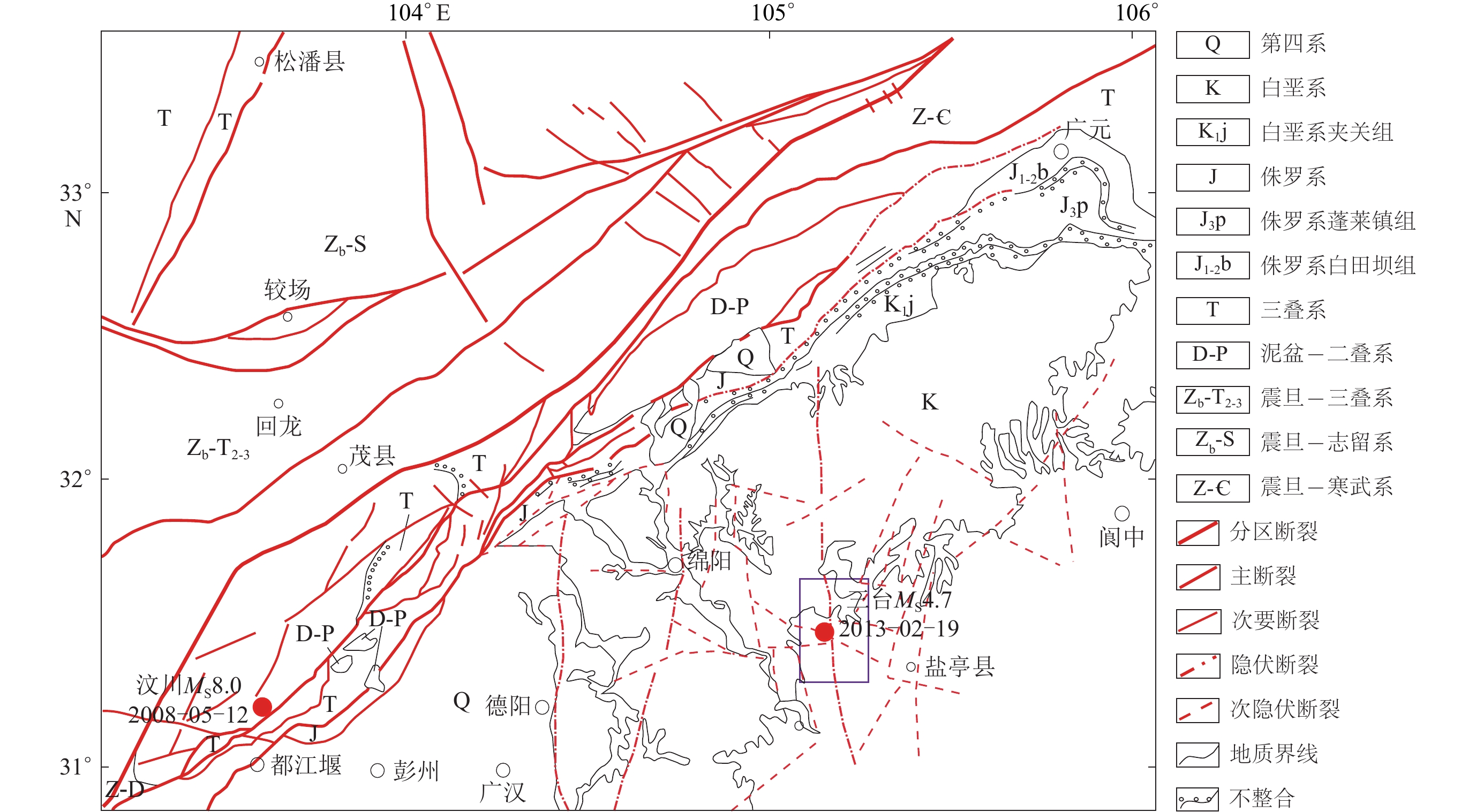
 下载:
下载:

